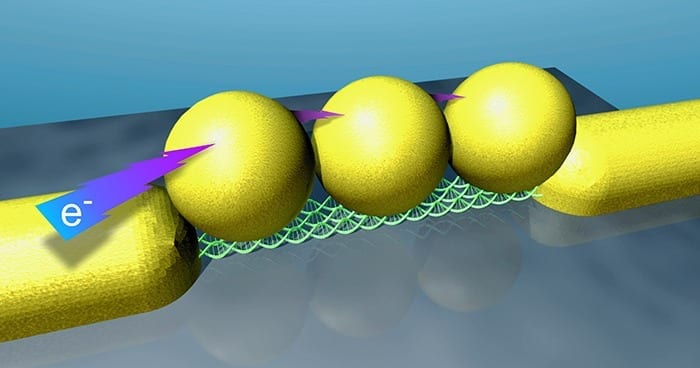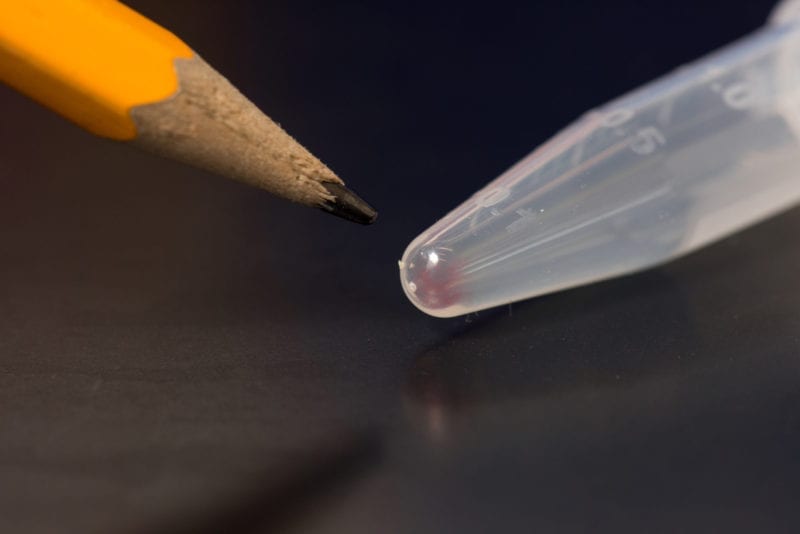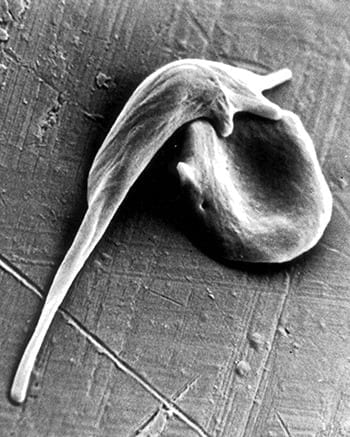
Nature has inspired generations of people, offering a plethora of different materials for innovations. One such material is the molecule of the heritage, or DNA, thanks to its unique self-assembling properties. Researchers at the Nanoscience Center (NSC) of the University of Jyväskylä and BioMediTech (BMT) of the University of Tampere have now demonstrated a method to fabricate electronic devices by using DNA. The DNA itself has no part in the electrical function, but acts as a scaffold for forming a linear, pearl-necklace-like nanostructure consisting of three gold nanoparticles.
The research was funded by the Academy of Finland.
The nature of electrical conduction in nanoscale materials can differ vastly from regular, macroscale metallic structures, which have countless free electrons forming the current, thus making any effect by a single electron negligible. However, even the addition of a single electron into a nanoscale piece of metal can increase its energy enough to prevent conduction. This kind of addition of electrons usually happens via a quantum-mechanical effect called tunnelling, where electrons tunnel through an energy barrier. In this study, the electrons tunnelled from the electrode connected to a voltage source, to the first nanoparticle and onwards to the next particle and so on, through the gaps between them.
“Such single-electron devices have been fabricated within the scale of tens of nanometres by using conventional micro- and nanofabrication methods for more than two decades,” says Senior Lecturer Jussi Toppari from the NSC. Toppari has studied these structures already in his PhD work.
“The weakness of these structures has been the cryogenic temperatures needed for them to work. Usually, the operation temperature of these devices scales up as the size of the components decreases. Our ultimate aim is to have the devices working at room temperature, which is hardly possible for conventional nanofabrication methods – so new venues need to be found.”
Modern nanotechnology provides tools to fabricate metallic nanoparticles with the size of only a few nanometres. Single-electron devices fabricated from these metallic nanoparticles could function all the way up to room temperature. The NSC has long experience of fabricating such nanoparticles.
“After fabrication, the nanoparticles float in an aqueous solution and need to be organised into the desired form and connected to the auxiliary circuitry,” explains researcher Kosti Tapio. “DNA-based self-assembly together with its ability to be linked with nanoparticles offer a very suitable toolkit for this purpose.”
Gold nanoparticles are attached directly within the aqueous solution onto a DNA structure designed and previously tested by the involved groups. The whole process is based on DNA self-assembly, and yields countless of structures within a single patch. Ready structures are further trapped for measurements by electric fields.
“The superior self-assembly properties of the DNA, together with its mature fabrication and modification techniques, offer a vast variety of possibilities,” says Associate Professor Vesa Hytönen.
Electrical measurements carried out in this study demonstrated for the first time that these scalable fabrication methods based on DNA self-assembly can be efficiently utilised to fabricate single-electron devices that work at room temperature.
Learn more: Researchers develop DNA-based single-electron electronic devices
The Latest on: DNA-based single-electron electronic devices
[google_news title=”” keyword=”DNA-based single-electron electronic devices” num_posts=”10″ blurb_length=”0″ show_thumb=”left”]
via Google News
The Latest on: DNA-based single-electron electronic devices
- Research combines DNA origami and photolithography to move one step closer to molecular computerson April 24, 2024 at 8:49 am
Molecular computer components could represent a new IT revolution and help us create cheaper, faster, smaller, and more powerful computers. Yet researchers struggle to find ways to assemble them more ...
- Study shines light on properties and promise of hexagonal boron nitride, used in electronic and photonics technologieson April 23, 2024 at 2:00 am
Single-photon emitters (SPEs) are akin to microscopic lightbulbs that emit only one photon (a quantum of light) at a time. These tiny structures hold immense importance for the development of quantum ...
- Analog Deviceson April 6, 2024 at 9:19 pm
and motion into electrical signals to be used in a wide array of electronic devices. We focus on key strategic markets where our signal processing technology is often a critical differentiator in ...
- Best Dog DNA Test Kits: A Veterinarian’s Reviewon March 2, 2024 at 11:43 pm
If you’ve been curious about your pup’s heritage, you may be surprised to learn about the existence of dog DNA test kits ... can decide which you prefer based on your needs.
- Securing Electronic Deviceson June 19, 2023 at 12:28 pm
Traveling with digital devices is often necessary in order to stay connected while you are away from the office or home. Here are several tips to keep you secure while you're traveling. Keep portable ...
- Harvesting Rechargeable Batteries From Single-Use Deviceson June 6, 2023 at 6:24 pm
[Becky] found these batteries in single-use disposable vape pens and so set about putting them to better use rather than simply throwing them away. While she doesn’t use the devices herself ...
- DNA Nanotechnology: Building Blocks of the Futureon March 26, 2023 at 12:45 pm
B) 2D DNA origami (smiley face serves as an example). C) Hollow 3D DNA origami shapes that are folded from 2D origami sheets. D) Lattice-based 3D origami (square and honeycomb lattice). E) 3D origami ...
- First DNA-based vaccineon January 10, 2022 at 9:29 am
The Indian DNA vaccine, called ZyCoV-D, will be used in the country on an emergency basis. It is administered through the skin using a needleless device, with an interval ... into muscle tissue In ...
- Semiconductor Materials & Deviceson August 16, 2020 at 2:59 am
Semiconductor devices and materials are ubiquitous. Such devices have transformed our world over the past few decades, enabling the internet age both in terms of fibre based communications and ...
via Bing News










